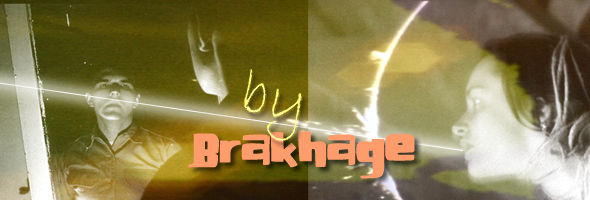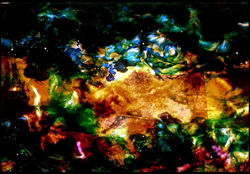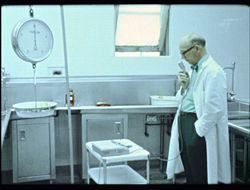
Color/B&W, 2003, 243m / Directed by Stan Brakhage / Criterion (US R1 NTSC)
The other 22 films are collected on the second disc and most have little to no traditional representational content. "Cat's Cradle" (1959) is a beautiful 6-minute light study using fabric, sunlight,
Anyone who attended film school during the 1970s or later will surely recognize Stan Brakhage as the creator of "Dog Star Man," a 75-minute avant garde masterpiece created between 1961 and 1964. An avalanche of cinematic technique using wild colors, endless superimpositions, and only traces of realistic footage (showing Brakhage and a dog trudging through the snowy wilderness, for example), this experimental epic influenced generations of artists and filmmakers while Brakhage himself remained on the fringes, turning out over 400 films of varying lengths before his death in 2003. 26 representative Brakhage films were chosen for this double-disc set, which offers an almost chronological tour through his pioneering techniques. As most of the films are silent, this may be tough going for avant garde newcomers; keep some CD accompaniment handy just in case.
 The first disc contains only four films, but they're among his most widely recognized and significant works. "Desistfilm" (1954) is an early study of light and shadow, buildings and the human form, which foreshadows in six minutes the visual obsessions he would explore over the next decade. The haunting and visually powerful "Wedlock House: An Intercourse" uses eerie black and white photography to depict a couple (played by Brakhage and his wife at the time, Jane) coming to terms with each other at an isolated house, staggered with negative footage of their rather explicit sex life. The aforementioned "Dog Star Man" comes next, accessible as either a complete film or divided into its original five segments ("Prelude," "Part 1," "Part 2," "Part 3," "Part 4"). Last is easily the most notorious Brakhage film of them all, 1971's "The Act of Seeing with One's Own Eyes" (a literal translation of the word "autopsy"), an unflinching and utterly clinical look at the autopsy process shot at a Pittsburgh morgue. Forget Faces of Death; this one will clear the room within seconds at your next dinner party, but it's also strangely gripping and beautiful if you're in a receptive frame of mind. Not surprisingly, Criterion has posted a prominent content warning before the start of the film.
The first disc contains only four films, but they're among his most widely recognized and significant works. "Desistfilm" (1954) is an early study of light and shadow, buildings and the human form, which foreshadows in six minutes the visual obsessions he would explore over the next decade. The haunting and visually powerful "Wedlock House: An Intercourse" uses eerie black and white photography to depict a couple (played by Brakhage and his wife at the time, Jane) coming to terms with each other at an isolated house, staggered with negative footage of their rather explicit sex life. The aforementioned "Dog Star Man" comes next, accessible as either a complete film or divided into its original five segments ("Prelude," "Part 1," "Part 2," "Part 3," "Part 4"). Last is easily the most notorious Brakhage film of them all, 1971's "The Act of Seeing with One's Own Eyes" (a literal translation of the word "autopsy"), an unflinching and utterly clinical look at the autopsy process shot at a Pittsburgh morgue. Forget Faces of Death; this one will clear the room within seconds at your next dinner party, but it's also strangely gripping and beautiful if you're in a receptive frame of mind. Not surprisingly, Criterion has posted a prominent content warning before the start of the film.
 a cat, and a young couple; "Window Water Baby Moving" (1959, 12 mins.) is a 16mm art film using footage of the birth of Brakhage's first child; the oft-screened "Mothlight" (1963, 3 mins.) is an abstract experiment using celluloid and light, as are "Eye Myth" (1972, 9 seconds!), "The Wold Shadow" (1972, 2 mins.), and his nature study/Bosch homage, "The Garden of Earthly Delights" (1981, 1 min.). Other films include "The Stars Are Beautiful" (1974, 18 mins.), "Kindering" (1987, 3 mins.), "I... Dreaming" (1988, 6 mins.), "The Dante Quartet" (1987, 6 mins.), "Nightmusic" (1986, 32 seconds), "Rage Net" (1988, 52 seconds), "Glaze of Cathexis" (1990, 3 mins.), "Delicacies of Molten Horror Synapose" (1991, 8 mins.), "Untitled (for Marilyn)" (1992, 10 mins.), the ominous "Black Ice" (1994, 2 mins.), the even more ominous "The Dark Tower" (1999, 2 mins.), "Study in Color and Black and White" (1993, 1 min.), "Stellar" (1993, 2 mins.), "Crack Glass Eulogy" (1996, 6 mins.), "Commingled Containers" (1997, 2 mins.), and "Love Song" (2001, 10 mins.). Apart from three 35mm films ("The Dante Quartet," "Nightmusic," and "Rage Net"), all are transferred from the original 16mm elements and look exactly as they should, with grain and rough splices intact. The image quality is quite good (certainly better than any of those film school prints) with robust colors. Brakhage and his estate were extensively involved in the creation of the disc, and the man himself appears in five video "encounters" which chronologically cover his filmmaking career and the effect it had on his personal life (and vice versa). Filmed in 1996, the discussions provide some much-needed context for many of the films, as do the written forewards which accompany each title. Also included is a thick annotated booklet with further liner notes and a handy essay by writer Fred Camper, all elegantly designed around individual frames from the films.
a cat, and a young couple; "Window Water Baby Moving" (1959, 12 mins.) is a 16mm art film using footage of the birth of Brakhage's first child; the oft-screened "Mothlight" (1963, 3 mins.) is an abstract experiment using celluloid and light, as are "Eye Myth" (1972, 9 seconds!), "The Wold Shadow" (1972, 2 mins.), and his nature study/Bosch homage, "The Garden of Earthly Delights" (1981, 1 min.). Other films include "The Stars Are Beautiful" (1974, 18 mins.), "Kindering" (1987, 3 mins.), "I... Dreaming" (1988, 6 mins.), "The Dante Quartet" (1987, 6 mins.), "Nightmusic" (1986, 32 seconds), "Rage Net" (1988, 52 seconds), "Glaze of Cathexis" (1990, 3 mins.), "Delicacies of Molten Horror Synapose" (1991, 8 mins.), "Untitled (for Marilyn)" (1992, 10 mins.), the ominous "Black Ice" (1994, 2 mins.), the even more ominous "The Dark Tower" (1999, 2 mins.), "Study in Color and Black and White" (1993, 1 min.), "Stellar" (1993, 2 mins.), "Crack Glass Eulogy" (1996, 6 mins.), "Commingled Containers" (1997, 2 mins.), and "Love Song" (2001, 10 mins.). Apart from three 35mm films ("The Dante Quartet," "Nightmusic," and "Rage Net"), all are transferred from the original 16mm elements and look exactly as they should, with grain and rough splices intact. The image quality is quite good (certainly better than any of those film school prints) with robust colors. Brakhage and his estate were extensively involved in the creation of the disc, and the man himself appears in five video "encounters" which chronologically cover his filmmaking career and the effect it had on his personal life (and vice versa). Filmed in 1996, the discussions provide some much-needed context for many of the films, as do the written forewards which accompany each title. Also included is a thick annotated booklet with further liner notes and a handy essay by writer Fred Camper, all elegantly designed around individual frames from the films.
